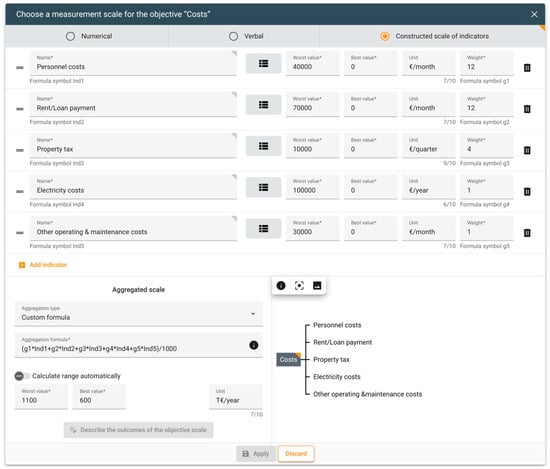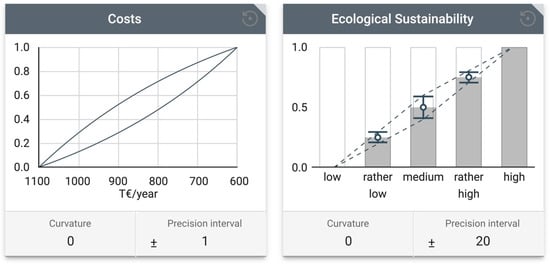Abstract
The Entscheidungsnavi is an open-source decision support system based on multi-attribute utility theory, that offers various methods for dealing with uncertainties. To model decisions with uncertainties, decision-makers can use two categories: Forecast and Parameter Uncertainties. Forecast Uncertainty is modeled with (combined) influence factors using discrete, user-defined probability distributions or predefined ‘worst-median-best’ distributions. Parameter Uncertainty allows imprecision for utilities, objective weights, and probability distributions. To analyze these uncertainties, the Entscheidungsnavi offers several methods and tools, like a robustness check, based on (Monte Carlo) simulations and a sensitivity analysis. The objective weight analysis provides insights into the effects of different objective weight combinations. Indicator impacts, tornado diagrams, and risk profiles visualize the impact of uncertainties in a decision under risk. Risk profiles also enable a check for stochastic and simulation dominance. This article presents the complete range of methods for dealing with uncertainties in the Entscheidungsnavi using a hypothetical case study.
Keywords:
multi-criteria decision-making; uncertainty; decision support system; value-focused thinking; multi-attribute utility theory MSC:
91B06
1. Introduction
Extensive research over the years has led to a plethora of different Multi-Criteria Decision-Making (MCDM) methods, whose strengths and limitations have been analyzed in numerous studies (e.g., [1,2]) and meta-studies [3]. In practice, software tools regularly accompany the application of these methods. The overview of the International Society on MCDM (https://www.mcdmsociety.org/content/software-related-mcdm-0, accessed on 30 March 2024) currently lists 28 tools, the majority of which are freely available. Most tools are based on a particular methodology, but a few offer a choice of methods (e.g., DEFINITE (https://spinlab.vu.nl/support/tools/definite-bosda/, accessed on 30 March 2024)).
Only a small number of MCDM tools focus on multi-attributive value or utility theory (MAVT/MAUT). MACBETH (https://m-macbeth.com, accessed on 30 March 2024) [4,5,6], for example, is a commercial decision support system (DSS) that has already been used in many different application contexts (e.g., [7,8,9]). FITradeoff (https://fitradeoff.org/, accessed on 30 March 2024) [10,11] and the Entscheidungsnavi (https://enavi.app/, accessed on 30 March 2024) [12] are available at no cost.
Decision-makers (DMs) seeking a method and software for their MCDM problems face a dilemma between ease of use and the quality of the decision recommendation. In general, the MAUT methodology [13] is considered demanding and difficult due to the trade-offs between objectives that need to be assessed. To reduce the application hurdles and avoid overwhelming the DM, certain methodologies, such as AHP [14] and outranking methods [15], are based on clear and simple queries. This also includes fuzzy methods [16,17], which deliberately anticipate a certain degree of fuzziness in the model. DMs can use these methods without having knowledge of the underlying algorithms. Although these lower demands on the DM reduce application hurdles and are often methodologically elegant, this can be at the expense of quality.
To achieve high decision quality, the DM needs to reflect on the decision problem. First of all, it is important to structure the decision situation, i.e., to clearly formulate the decision statement, analyze the fundamental objectives, and creatively develop alternatives [18,19]. Back in the 1990s, Keeney introduced the concept of Value-Focused Thinking (VFT), which has proven itself in many practical applications (e.g., [20,21,22]. If DMs are not supported during this phase of structuring, there is a risk that the problem will not be properly defined [23], the objectives will be incomplete or not fundamental [24], and potentially attractive alternatives will be overlooked [25].
Secondly, DMs must research and use relevant and reliable information. Furthermore, an evaluation or decision should be based on comprehensible logic and the DM’s identified preferences [19]. A transparent and comprehensible process prevents a black-box character, enabling the reflection of the DM’s preferences. MAUT has clear advantages over most other methods in this respect. The reason for this can be explained by the comparatively simple and strictly decomposition mathematics combined with a theoretically clean foundation [13]. Although the trade-offs between objectives required by MAUT are—as mentioned above—difficult to determine, they can be clearly interpreted in terms of content without further fuzziness. In addition, possible effects on the result are generally easy to understand. In terms of clarity and comprehension, MAUT is an evaluation logic that is highly reflective and transparent.
MAUT enables the consideration of uncertainties in various ways. This concerns not only the integration of risk preferences in utility functions based on axioms [26] but also the possibility of easily integrating various standard methods for dealing with uncertainties into the model. Which methods are suitable here and what an extension of these methods should look like should be based on how beneficial this integration is for the desired reflection of the DM. When faced with uncertainty, DMs can ask themselves, for example, the following questions to reflect on the decision situation: Are the parameters I have entered aggregated in a comprehensible and plausible way to produce a valid result? Are the uncertainties considered in the model exactly the uncertainties that may have a decisive influence on the result? To what extent can the respective uncertainties have a positive or negative impact on the result? Which uncertainties have the greatest influence on the result?
The Entscheidungsnavi is, as far as we know, the only DSS that comprehensively supports the DM in structuring decision-making situations, applying a transparent mathematical method for calculating the best alternative, and addressing these questions with regard to uncertainties. In the decision front-end, VFT [18] is used to structure the decision situation and identify the first pieces of relevant information (objectives and alternatives). In his recent book, Keeney [27] also refers to the Entscheidungsnavi as the only tool comprehensively supporting VFT. In the decision back-end, the concept of MAUT [13] is used to find the best alternative under uncertainty. In addition, the Entscheidungsnavi offers many different evaluation methods that allow the DM to reflect on and analyze their results.
In this paper, we present how to deal with uncertainties and how to analyze the questions mentioned above in the Entscheidungsnavi using a simple hypothetical case study. Therefore, we briefly introduce the Entscheidungsnavi (Section 2) and a case study (Section 3) that is constructed to show all available analysis tools and options for facing uncertainties in the following sections. In Section 4, we explain the implementation of MAUT in the Entscheidungsnavi, and in Section 5, we show how uncertainties can be modeled in the DSS. In Section 6, Section 7, Section 8 and Section 9, we present the following various analysis tools with which uncertainties can be examined more closely by the DM: methods for checking the robustness of the result (Section 6), objective weight analysis (Section 7), sensitivity analysis (Section 8), and indicator impacts, tornado diagrams, and risk profiles (Section 9). In Section 10, we conclude the paper and point out limitations in dealing with uncertainties in the Entscheidungsnavi.
3. Case Study
To subsequently explain the mathematical models and functionalities of the Entscheidungsnavi regarding the handling of uncertainties, we would first like to briefly introduce a case study in this section. It is important to note that this case study is a highly simplified model of a logistics decision and was solely created to explain how DMs can deal with and analyze uncertainties using the Entscheidungsnavi.
258 GmbH, a company that sells on-site-stored wood, would like to expand as part of its growth strategy. For this purpose, it is looking for a new location in North Rhine-Westphalia (NRW), Germany. The company’s decision statement is as follows: ‘Which location best suits the new wood warehouse with adjoining wood sales for 258 GmbH?’
The company has already defined the objectives and alternatives of the decision statement and determined how well the alternatives fulfill the objectives in a consequences table (see Figure 1).
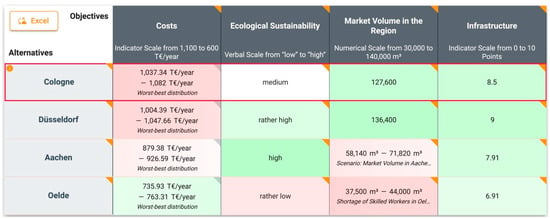
Figure 1.
Consequences table for the decision statement ‘Which location best suits the new wood warehouse with adjoining wood sales for 258 GmbH?’. Good consequences are displayed in green, while average ones are displayed in white and bad ones are displayed in red.
258 GmbH defines four fundamental objectives: Costs, Ecological Sustainability, Market Volume in the Region, and Infrastructure.
The objective Costs deals with the expected annual costs for the operation of their wood sales business, including the wood warehouse, which, among other expenses, are costs for rent, the property lease, interest costs and loan repayment costs for the property, personnel costs, taxes and duties, and maintenance and operating costs. The model does not consider transport costs and sales tax, as they will be passed on to the customer through an increased retail price based on the location of the warehouse. The objective is measured using an indicator scale from 1100 T€/year (worst value) to 600 T€/year (best value), which is made up of five indicators: Personnel costs (€/month), Rent/Loan payment (€/month), Property tax (€/quarter), Electricity costs (€/year), and Other operating & maintenance costs (€/month).
The objective Ecological Sustainability evaluates properties at different locations based on their ecological sustainability. It is measured using a verbal scale from low (worst value) to high (best value), with five verbal levels.
The objective Market Volume in the Region is measured in terms of the expected volume of construction wood sold in m3. This takes two factors into account: geographical reach and competition. In large cities, we assume that residents travel a maximum distance of 50 km to buy wood. In more rural areas, we assume that residents travel up to 100 km to buy wood, as residents there are used to traveling longer distances to make purchases. To assess competition, we consider the extent of potential competition at the locations. We assume that there is already an abundance of wood merchants, particularly in urban centers. The objective is measured on a numerical scale from 30,000 m3 (worst value) to 140,000 m3 (best value).
The last objective, Infrastructure, is made up of two indicators: Current state of infrastructure and Expected future state of infrastructure. These indicators are used to assess the infrastructure at each location in terms of its quality and possible restrictions (e.g., due to extensive construction sites) now and in the future. Aspects such as highway connections, railways, shipping routes, and the general volume of traffic in the region are evaluated holistically. Airports are not considered in this model, as airplanes are not suitable for transporting the goods offered. The objective is measured using an indicator scale that ranges from 0 (worst value) to 10 points (best value).
Furthermore, 258 GmbH has already limited its choice of alternatives to four locations: Cologne, Düsseldorf, Aachen, and Oelde. Each alternative represents a specific property in the city. As the largest city in the Rhineland, Cologne offers excellent infrastructure with major highways, the Rhine port for transporting goods, and a lot of craftsmen and construction companies nearby. Düsseldorf, the state capital of NRW, has a strong economy, a well-developed road network, and a high density of construction sites. Aachen is located in the west of NRW, bordering Belgium and the Netherlands, which offers the strategic advantage of being able to sell to people from three countries. The region is also characterized by a decent amount of construction activity. Oelde is a small town in the east of NRW. The town is characterized by its excellent connection to the highway and offers the opportunity to set up a medium-sized wood warehouse.
The performance of the alternatives is assessed with regard to all objectives on the respective objective’s scale in the consequences table (see Figure 1). As some consequences are uncertain and depend on external factors, several influence factors are used. Examples of influence factors are the worst–best distribution, which is used to model a kind of general uncertainty regarding consequences, or the ‘Shortage of Skilled Workers’ in Oelde. In the following sections, we will discuss these uncertainties and the different methods with which to analyze them in the Entscheidungsnavi in more detail.
6. Methods for Checking the Robustness of the Result
While including FUs and PUs can greatly increase the complexity of the decision model, it often cannot be avoided. The expected utility of the MAUT model only captures the resulting risk in a limited way, as extreme results for rare events can be concealed by the method of aggregation. The robustness check can, however, reveal these risks and serve as a good starting point to identify alternatives and uncertainties that warrant further consideration. Using a simulation approach, the tool calculates a ranking of the alternatives for randomly generated scenarios that are based on the previously defined PUs and FUs with their given probabilities. It, therefore, helps the DM check how robust the ranking of alternatives is, pointing out scenarios in which an otherwise promising alternative might fall behind.
The analysis is based on a Monte Carlo simulation [35], as even decision models that are otherwise manageable in size can easily result in an infeasible number of calculations. For example, having a decision model with five alternatives and five objectives that are each measured through five indicators, using the predefined influence factor (with three states) for all forecasts results in different possibilities due to stochastic independence, making it infeasible to calculate an analytically correct result, even on the fastest computer to date. The simulation approach in the Entscheidungsnavi provides a very good approximation of this result with only a few million iterations. Furthermore, the DM can select the FUs, i.e., influence factors, and PUs, i.e., uncertainties regarding probabilities, utilities, and objective weights, for which they want to check robustness. This allows for specific analyses to be carried out while also giving the option to reduce computational complexity.
Running the simulation with enabled FUs generates information on how the alternatives react to the given influence factors, i.e., external factors out of the control of the DM. In this kind of simulation, it can be interesting to examine which requirements are necessary for an alternative to be the best and how likely these requirements are to be met. To generate this information, the specific state of every individual influence factor is drawn according to the discrete probability distribution of the influence factor for every simulation iteration. The states of combined influence factors are determined by a combination of states of the individual influence factors.
By enabling PUs for the simulation, DMs gain insights into how their inability to precisely elicit certain parameters affects the result. Based on this information, the DM can consider whether they should spend more time and effort on determining the parameters of the model or not. If the model is sensitive to PU (i.e., the best alternative depends on a randomly drawn parameter within the given interval), the DM should try to give a more precise assessment to aid the overall robustness of the model. To examine the influence of PUs, the uncertain parameters of every simulation iteration are determined according to the methodology explained in Section 5.2.
It is also possible to analyze the robustness of PUs and FUs simultaneously. This generates the most substantial insights, as every kind of uncertainty is considered. Any inferences on the robustness of the outcome should generally be based on a simulation covering PUs and FUs, while analyzing only individual PUs and FUs can aid the decision-making process through the generation of specific information. When running the simulation with FUs and PUs, a specific discrete probability distribution is drawn for all selected influence factors with imprecise probabilities for every simulation iteration. These specific probability distributions are then used to draw the specific states for every influence factor, as previously described for the case where only FU occurs.
The outcome of the Monte Carlo simulation is visually presented to the DM (see Figure 7). The Entscheidungsnavi shows a tabular overview of how often each individual alternative was ranked first, second, third, etc., in the simulation iterations performed. A score is calculated from all the frequencies for every alternative, which reflects the weighted average of ranks achieved on the basis of these frequencies. The lower this score is, the more frequently an alternative is in the top ranks and the more attractive it is. This score is used to check for a new form of dominance, namely, simulation dominance. It can be regarded as similar to stochastic dominance in that it takes probabilities into account. An alternative that achieves a score of exactly one absolutely dominates all other considered alternatives according to the simulation: i.e., it is better in every single iteration of the simulation. If the score deviates from one, no strict simulation dominance exists. The score can, however, still be interpreted as the degree of dominance.
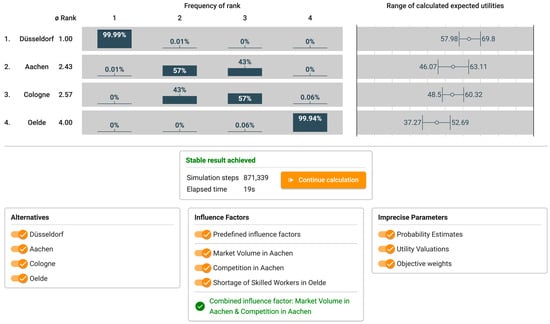
Figure 7.
Robustness check of case study in Entscheidungsnavi.
When only two alternatives are considered, the score for the alternatives can lie between one and two, and their sum adds up to three. As previously mentioned, an alternative with a score of one absolutely dominates the other alternatives, while a score close to one will indicate a strong degree of dominance of one alternative over the other. A score of 1.1 indicates that the alternative is better in 90% of cases, for example. A complete lack of dominance between the alternatives is ascertained when the scores for both alternatives are 1.5, i.e., when they are both the better alternative in 50% of the cases.
The Entscheidungsnavi also collects information on which states or which combination of states is necessary for the rank of an alternative. In the case where a state occurs in all scenarios that lead to a specific rank for an alternative, this information is deemed to be a requirement for the alternative to achieve a specific rank and will be presented to the DM. Additionally, the DM is presented with the range of calculated (conditional) expected utilities for each alternative to better grasp the extent of the impact on the individual alternatives. This can be interesting in cases where a DM wants to avoid risk and opt for an alternative that may be ranked lower in the average rank but shows little deviation in the expected utility across all simulation runs.
For efficiency reasons, the simulation is stopped once the average maximum change in the frequency with which an alternative achieves a rank is below per iteration over the course of one second for any alternative. This is considered a stable result that approximates an analytical result well while keeping the necessary resources to a minimum. The DM can, however, always choose to continue the simulation if they want more valid results.
In this case study, the alternative Düsseldorf ranks first in almost all simulation iterations (see Figure 7). The expected utility varies between 57.98 and 69.80 and is only surpassed by the utility of Aachen in very few constellations. Depending on the values drawn, the second- and third-placed alternatives change, too. Aachen ranks second in 57% and third in 43% of iterations. Cologne ranks second in 43% and third in 57% of iterations. Oelde ranks last in almost all iterations (99.4%) of the simulation, while in a few cases, Cologne becomes the worst alternative (0.06%). While the result shows a very strong preference for the warehouse in Düsseldorf, there is still a small risk involved where Aachen would be the best alternative. Therefore, it is reasonable to further explore the conditions under which Aachen should be chosen for the location of the warehouse.
Hovering over the frequency bar for Aachen in the first place gives 258 GmbH insights on the necessary requirements (see Figure 8) to reach this rank. The Entscheidungsnavi provides the DM with information on the necessary influence factor states, objective weights, and utilities. In this case, Aachen only becomes the best alternative through a combination of FUs and PUs. This is indicated by the necessity for the influence factors on the left and the deviations of the objective weights and risk aversion parameter from their defined means and , respectively.
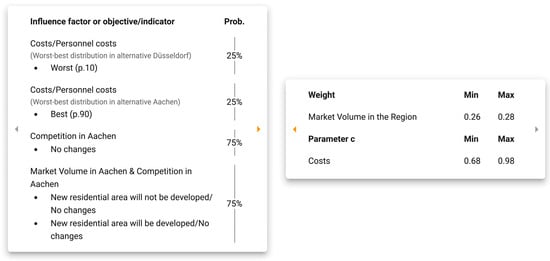
Figure 8.
Necessary requirements for Aachen to become best alternative.
7. Objective Weight Analysis
Eliciting one’s objective weights is one of the hardest parts of the decision-making process. In many cases, DMs are uncertain about their objective weights, up to the point where they cannot even properly elicit them using precision intervals. In these cases where DMs have a high PU regarding the objective weights, the objective weight analysis can be a helpful starting point to see which objective weight intervals would result in different outcomes, i.e., a different alternative with the highest expected utility.
The objective weight analysis uses a simulation approach and determines a range of statistical measures for the different objective weights that result in an alternative being the best, namely, the minimum, maximum, p.10 and p.90 quantiles, median, and average. These are initially determined by different objective weight combinations algorithmically chosen in each calculation step. The number of increments of the objective weights describes the granularity with which the objective weights are altered during the simulation and depends on the number of objectives . The incrementation values have been chosen to provide a good ratio between the number of necessary calculations and the granularity of the objective weights. The different increment numbers can be seen in Formula (12).
The number of iterations for the algorithm depends on the number of objectives and amounts to the number of increments to the power of the number of objectives, i.e., , and ranges between 500 thousand and 4.7 million for decisions with 14 or fewer objectives. For the calculation of the objective weights, we introduce the notation for the greatest integer less than or equal to z. Furthermore, we use the binary operation , as used in computer science [36], which returns the remainder of the division for any real numbers and (13a).
With this, we calculate the objective weight for objective in iteration of the algorithm according to Formula (13b).
To generate all possible objective weight combinations with the number of increments, we need a function that iterates through the different incremental values for the different objectives. The term delays the incrementation of by a factor equal to the number of increments from one objective to another objective weight ; i.e., the function will repeat the same value for times before increasing the value by one. Furthermore, the function helps us ensure that we always have as many different integer results as we have increments: i.e., for an input value that is a multiple of the increments, the result will be zero, while the results are between one and the number of increments minus one for all other input values. In combination, this allows us to iterate through every possible objective weight combination regarding the number of increments. We can then multiply this value by to generate equidistant unnormalized objective weights between zero and one.
If, at the end of the algorithm, the change in any of the statistical values recorded is greater than 0.05% for the calculations during the last ½ second of the algorithm, the Entscheidungsnavi will continue the simulation with randomly generated objectives weights until the maximum change in any of the values for all calculations during ½ second is less than 0.05%. Either way, the normalized objective weights will be determined for every objective and every iteration according to Formula (14) to obtain a valid set of objective weights for every iteration of the algorithm.
Figure 9 shows the objective weight analysis in the Entscheidungsnavi based on the case study. On the left, the DM can see how often an alternative has ended up in first place across all simulation runs. By default, the alternatives that most frequently reached first place are at the top. In the bar chart in the middle, the DM can see the average objective weights of the entire simulation for which the alternatives were the best (display: average) and the range of objective weights that can occur while an alternative is the best. In the more detailed view (display: distribution), the DM can also see the medians, the maximum and minimum values, and the p.10 and p.90 quantiles of the drawn objective weights with which the corresponding alternative has ended up in first place. The DM can also change the quantiles in this view to p.25 and p.75 quantiles.
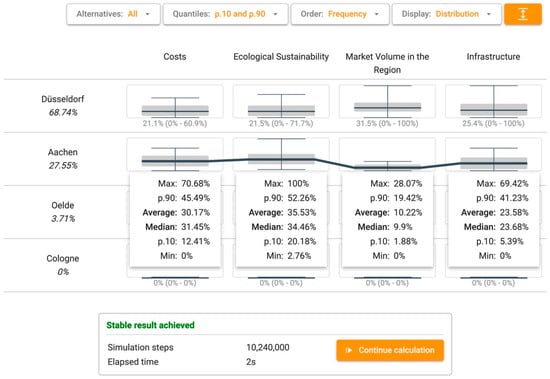
Figure 9.
Objective weight analysis in the Entscheidungsnavi.
The objective weight analysis (Figure 9) further strengthens the robustness of the result with Düsseldorf as the warehouse’s location. Even with objective weights outside the specified uncertainty, it is still the most promising location in 68.74% of cases. Only objective weights of 61% and above for Costs and above 71.7% for Ecological Sustainability hinder Düsseldorf from being in first place. However, in 27.55% of cases, Aachen becomes the best alternative when varying the objective weights. The narrow interval of possible objective weights for Market Volume in the Region can be attributed to Aachen’s relative weakness in that regard. The upper limit of 28.07% is, however, still within the uncertainty interval defined by 258 GmbH for this objective. Therefore, further analysis should be conducted.
Above the bar chart, DMs can also select which alternatives should be displayed. In addition, they can change the sorting based on their gut feeling. With the button on the top right, DMs can choose to vertically enlarge the diagram. When the DM hovers over the bars, the exact values of the different parameters are shown (see Figure 9).
8. Sensitivity Analysis
The sensitivity analysis helps DMs to check the plausibility of the model, i.e., whether the different parameters have the expected impact on the result and how big the impact is. This is mainly enabled by the multidimensional approach of the Entscheidungsnavi. While most other tools only allow a unidimensional analysis of the changes caused by varying a parameter, the Entscheidungsnavi offers the option to vary all parameters simultaneously. This allows the DM to analyze the impact of multiple uncertainties at the same time, which gives more realistic results than changing just one value at a time.
The sensitivity analysis allows the variation in the following parameters of the decision model: objective weights, utilities, probabilities of FUs, consequences, and indicator weights. Corresponding slider boxes are available for each parameter. The effects on the resulting ranking and utilities of alternatives can be observed while changing the slider. It is also possible to select which alternatives are shown.
The detailed display option for expected utilities shows the utility broken down into the contribution of each objective. Hovering over the colored bars shows the DM which objective the shown utility belongs to. All values are multiplied by 100 for better readability.
If imprecise parameters have been chosen, the precision interval specified by the DM is marked graphically on the slider with a dark-gray area. The DM can use this to easily check whether there are any effects on the result within the previously defined intervals.
In the case study, 258 GmbH can use the sensitivity analysis to analyze the risks previously identified in the robustness check and objective weight analysis. Figure 10 shows the analysis regarding PU and confirms the findings indicated by the simulation of the robustness check. Even when all PUs take the least favorable values for Düsseldorf in accordance with the defined uncertainty intervals for the respective parameters, it still remains on top. 258 GmbH has minimized the objective weight for Market Volume in the Region (orange bar), where Düsseldorf has a higher utility than Aachen. It has also maximized the risk aversion parameter , benefiting Aachen’s utility value, as the concave utility function generates a higher utility increase for Aachen than it does for Cologne as if the utility function were linear. Lastly, it has minimized the utility value for the rather high consequence level of the objective Ecological Sustainability, which is the consequence for Düsseldorf. As changing the PUs is not sufficient to put Aachen in first place, it can be said that the choice of location must also depend on the FUs identified in the robustness check (Figure 8), i.e., costs associated with the warehouses at the locations, the level of competition, and market volume in Aachen. Knowing this, 258 GmbH could try to perform a more precise assessment of the probabilities or the costs to minimize the effect of uncertainty on the model or use other types of analyses to assure themselves that they are making the right choice.
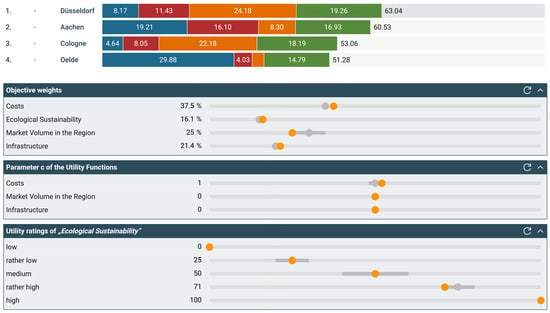
Figure 10.
Sensitivity analysis for PU impact.
Figure 11 shows the continued analysis, this time regarding the risks from the objective weight analysis. Even though they were only uncertain about the exact objective weight of Market Volume in the Region, it is still reasonable to ensure that the result is maximally robust in this regard. Using the average objective weights that put Aachen in first place in the objective weight analysis, they conducted an extended investigation into possible thresholds that change the result. The starting point shows a considerable lead in utility for the location in Aachen but also a high deviation from the elicited objective weights for Ecological Sustainability and Market Volume in the Region, pointing to a strength in the first and a weakness in the latter for Aachen. Gradually increasing the objective weight for Market Volume in the Region shows that upon reaching an objective weight of 19.4%, Düsseldorf becomes the best alternative yet again. The same happens at 9.8% when decreasing the objective weight for Ecological Sustainability. A third analysis shows that even when trying to deviate as little as possible from the original objective weights, there is still a major deviation necessary to put Aachen in first place.
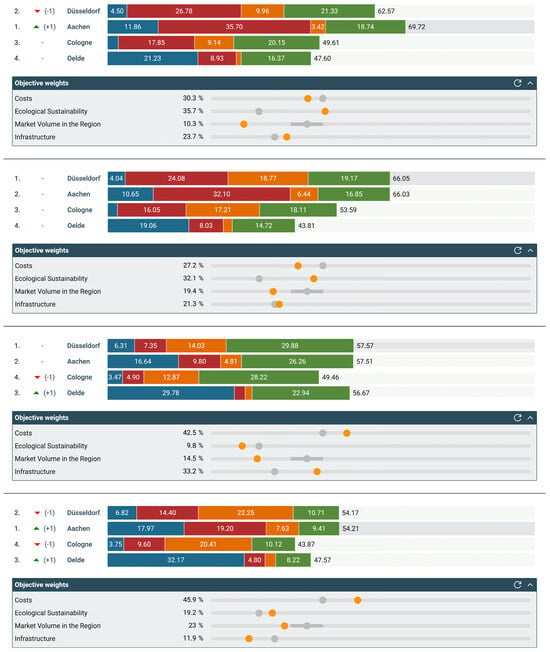
Figure 11.
Sensitivity analysis for the impact of objective weights with detailed utilities for the objectives Costs (blue), Ecological Sustainability (red), Market Volume in the Region (orange), and Infrastructure (green).
9. Indicator Impacts, Tornado Diagrams, and Risk Profiles
There are three ways to visualize uncertainties and their associated risks in the Entscheidungsnavi: indicator impacts, tornado diagrams, and risk profiles.
9.1. Indicator Impacts
Indicator scales are helpful in assessing consequences because they give DMs a more granular form of input. When they are combined with influence factors, the Entscheidungsnavi can visualize the impact of the uncertainty for individual indicators on the overall consequence of an objective. Therefore, using indicator scales also makes it easier for DMs to gain insights into the main contributing factors for the consequences in a matrix cell and their associated risks. This can inform DMs for which uncertainties it would be most beneficial to gather more exact predictions and for which uncertainties the increased effort might be too costly.
The indicator impact diagram is available for every cell of the consequences table where an indicator scale is utilized. The diagram clearly shows which indicators have the greatest, the second greatest, etc., impact on the outcome for such a cell based on the respective existing FU. Depending on the type of influence factor used, i.e., user-defined or predefined, the DM is presented with different information and has different options to modify the diagram.
When the predefined influence factor is used, the impact of the indicators is initially determined under the assumption that either the Worst, Median, or Best state occurs for the indicator for which the impact is being determined, and the Median state occurs for all other indicators (selection: simple variant). The DM can, however, choose to have the impact determined under the assumption that either the Worst, Median, or Best state occurs for the indicator for which the impact is being determined and the states of all other indicators occur with a frequency according to their defined probability distributions (selection: probabilistic variant). To generate the information regarding the indicator impacts for user-defined influence factors, we treat the indicators as if their states were stochastically independent, even though they are not, and always calculate their impacts according to the probabilistic variant.
Figure 12 shows the indicator impacts on the objective Costs for the alternative Cologne in the Entscheidungsnavi. 258 GmbH can choose between three different display options for the range of the results scale: total scale (the entire bandwidth of the scale is used as a basis), worst–best scenarios (the limit of the scale results from a combination of the indicated best or worst results of the indicators), and adjusted (the range adjusts to the actual width of the indicator impact diagram). Moreover, the indicators can be sorted by their influence on the result or in the order in which the DM defined them.
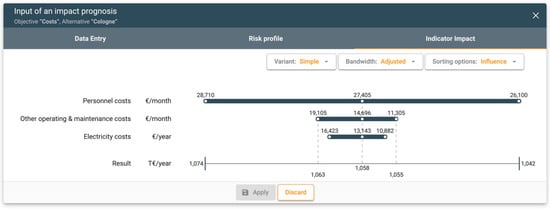
Figure 12.
Indicator impacts for the objective Costs in the alternative Cologne in the Entscheidungsnavi.
In this case study, the indicator Personnel costs has the biggest impact on the result of the objective Costs in the alternative Cologne, followed by the indicators Other operating & maintenance costs and Electricity costs. The indicator Other operating & maintenance costs causes the result to vary between 1063 T€/year and 1055 T€/year. Hovering over the bars will show these values to the DM.
9.2. Tornado Diagrams
Similarly to indicator impact diagrams, tornado diagrams present the DM with information about the impact of uncertainties on the utility, however, on a larger scale. They show the resulting change in expected utility for an alternative based on certain events occurring, i.e., conditional expected utilities. These effects can be analyzed in isolation when choosing a single alternative or in comparison to another alternative. This comparison is particularly interesting if the decision is to be made between two alternatives. In such a case, the DM can clearly see under which circumstances one alternative is better and for which uncertainties. The influence factor with the greatest impact and, therefore, the widest bar is shown at the top, and the other influence factors follow in descending order of impact. This also sheds light on which uncertainties should preferably be analyzed further, e.g., through more precise probability estimates, if the DM wants to reduce uncertainty in the decision situation.
Figure 13 shows a comparison of two alternatives, Cologne and Aachen, in the tornado diagram. It helps the DM reflect how the uncertainties from the defined influence factors affect the evaluation of the alternatives.
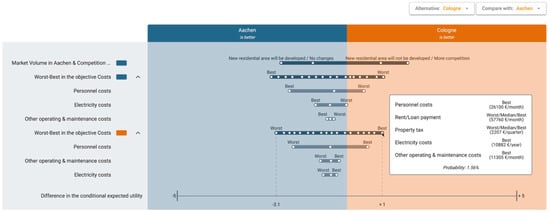
Figure 13.
Tornado diagram for overall result in Entscheidungsnavi.
If an objective is assessed through multiple indicators and the assessment is based on the predefined influence factor, DMs can expand the influence factor on the left and see the isolated effects of uncertainty on the individual indicators.
In the case study, 258 GmbH selects a compared alternative (Cologne) on the top right (see Figure 13). It is evident in the comparison of the two alternatives that uncertainties have the greatest impact on the relative advantage. Colored rectangles next to the influence factor names indicate which alternative the uncertainty refers to. Here, the combined influence factor ‘Market Volume in Aachen & Competition in Aachen’ has the greatest impact on the difference in the conditional expected utility, which varies between −1.9 and +1.8. Furthermore, 258 GmbH has the option to analyze the impact of the predefined influence factor in more depth. For the objective Costs, the conditional expected utility ranges between −2.1 and +1.0 because of the worst–best influence factor. By hovering over the individual points, DMs can see which indicator states lead to a certain conditional expected utility and how likely they are. With this illustration, the company can clearly see which states of the influence factor occur for the indicators when an alternative is better.
9.3. Risk Analysis
The Entscheidungsnavi offers multiple ways to analyze the risk associated with choosing an alternative. This analysis can be either conducted individually for every objective or aggregated over all objectives. When considering all objectives, it is also possible to analyze risk with and without the DM’s preferences and objective weights.
9.3.1. Individual Risk Profiles and Stochastic Dominance
Risk profiles can be considered a tool for experts with profound knowledge in decision theory. They show the likeliness of exceeding results and can, therefore, be used to check for dominance. In some cases, this can help DMs eliminate alternatives from consideration to reduce the complexity of the model and, therefore, efficiently use the resources available.
A risk profile shows the probability of exceeding a certain result . This means that has a complementary relation to the distribution function , i.e., . The DM can generate a risk profile for each cell in the consequences table, i.e., with , for an alternative regarding a single objective that is determined using the distribution function for the specific influence factor . Based on this, comparisons can be made with other alternatives regarding the same objective, and first-degree stochastic dominance (for this context, see Hadar & Russell [37]) can thus be determined graphically for a single objective.
This type of dominance check is also conducted automatically, simultaneously over all objectives on a mathematical basis once the assessments of alternatives in the objectives have been completed. This is referred to as the dominance of alternative over if stochastically dominates in all objectives, i.e., if the risk profile for alternative is identical to or above that of alternative and above it for at least one point (see Formula (15)). Neither utility functions nor objective weights need to be defined for this.
Alternatives that are dominated by another alternative are marked in red with an info button. Clicking on this info button shows which alternative(s) dominate(s) the one in question. DMs can use this information to carefully consider whether or not to further analyze alternatives that are stochastically dominated for all objectives. Even if an alternative is dominated, it can still be the best alternative in rare scenarios. If an alternative is dominated by multiple alternatives or an alternative for which the assessment depends on the same influence factors, DMs can likely exclude it from further analysis.
In the case study, the alternative Düsseldorf dominates the alternative Cologne, as shown by the red marking in Figure 14. However, Düsseldorf only stochastically dominates Cologne over all objectives. While Cologne also achieves better outcomes than the other two alternatives for most objectives, Aachen and Oelde achieve better outcomes than Düsseldorf for Ecological Sustainability and Costs, respectively.
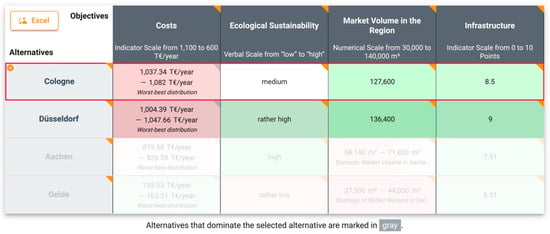
Figure 14.
Checks for stochastic dominance in the Entscheidungsnavi.
9.3.2. Risk Comparison
DMs can also analyze the risk associated with the alternatives on the basis of their preference statements regarding utilities and objective weights. The risk comparison shows the overall utilities of the alternatives, i.e., , with , aggregated across all objectives. The x-axis then shows the possible utilities of the alternatives, each of which only results under the condition that certain overall forecast scenarios occur. In this representation, the utility functions used are, strictly speaking, no longer interpreted as utility functions but as value functions. For the difference between these two functions, see Dyer and Sarin [38,39]. The information shown in the diagram is generated via a Monte Carlo simulation. The underlying data are equivalent to those generated in the robustness check when only FUs, i.e., influence factors, are considered.
Figure 15 shows the risk comparison for the case study. It confirms the previous finding that opening the wood warehouse in Düsseldorf is a good choice, as it further confirms the previous finding regarding the alternative’s robustness. By analyzing the diagram, 258 GmbH can see that Düsseldorf can be regarded as the best alternative when looking at the likeliness of attaining an overall utility level, as it has the highest probability of all alternatives of exceeding any given utility.
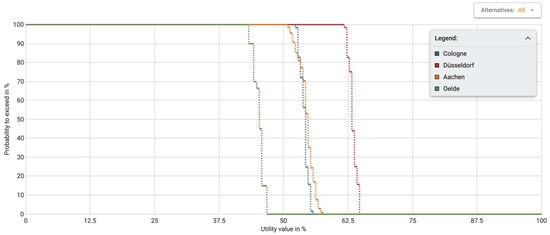
Figure 15.
Risk comparison in the Entscheidungsnavi.
10. Conclusions
This paper shows how uncertainties are integrated into a multi-criteria decision analysis in the DSS Entscheidungsnavi and how the methods and analyses can help support the desired reflection of the DM. Therefore, different types of uncertainties are described, and various methods are explained to analyze these uncertainties. The basic mathematical model in the system is the additive utility function of MAUT, which allows two types of uncertainties: Forecast Uncertainties (FUs) and Parameter Uncertainties (PUs). FUs can be modeled by influence factors in the consequences table. In the Entscheidungsnavi, a distinction is made between user-defined and predefined influence factors. User-defined influence factors can either be individual or combined influence factors. The predefined influence factor is based on a ‘worst-median-best’ distribution. PUs can be used if DMs cannot precisely determine the parameters of a decision model and only imprecise information is available. In the Entscheidungsnavi, PUs can be modeled for three different parameters: utility functions, objective weights, and the probabilities of the influence factors. With the help of PUs, DMs can define the intervals of these parameters. Furthermore, the paper presents various methods and analyses to check the impact of uncertainties, namely, methods for checking the robustness of the result, objective weight analysis, sensitivity analysis, and indicator impacts, tornado diagrams, risk profiles.
In the robustness check, a Monte Carlo simulation is used to check how robust the result is regarding FUs and PUs. This analysis gives DMs a better insight into how stable the ranking of the alternatives is regarding previously determined uncertainties. The objective weight analysis can be used as a starting point to see which objective weight intervals would result in a different ranking of alternatives. In the sensitivity analysis, DMs can analyze which parameters impact the result of the decision and to what degree. It is possible to vary the following parameters: objective weights, utilities, probabilities of FU, consequences, and indicator weights. Indicator impacts, tornado diagrams, and risk profiles help DMs visualize risks in the decision model. With the help of checks for stochastic and simulation dominance, DMs can identify dominated alternatives without determining utilities or objective weights.
The limitations of the proposed mathematical model under MAUT shown in this paper are the general applicability of the additive model and the use of expected utilities according to von Neumann and Morgenstern [26]. We assume (and demand) that the objectives of the decision situations are fundamental, measurable, redundancy-free, complete, and preference-independent. Other limitations are of a technical nature with regard to the possible and necessary number of iterations in the Monte Carlo simulation to reach a satisfactory validity of the results. In the case of the objective weight analysis, this is counteracted by gradually decreasing the granularity with which the objective weights are altered with an increasing number of objectives. Furthermore, due to the high development speed of browser engines and their supported technology, the Entscheidungsnavi officially only supports the last three major browser versions for the most common browsers, i.e., Firefox, Chrome, Safari, and Edge. While it will mostly run on older browsers as well, some functionalities might be limited or missing, as the tool often relies on new browser functions to support the best user experience possible.
In the future, further functionalities will be added to the Entscheidungsnavi. For example, it should soon be possible to use correlated combined influence factors to display FUs in the consequences table. Furthermore, a team version is currently being developed in which it will be possible to work with several team members on a decision situation and analyze it. The uncertainties in such a team decision result from the different preferences and information bases of the individual team members. It is important to create transparency here so that a considered decision can be made in the interests of all team members.
Author Contributions
Conceptualization, S.P., M.T. and R.v.N.; formal analysis, S.P. and M.T.; project administration, S.P., M.T. and R.v.N.; resources, S.P. and M.T.; software, S.P. and R.v.N.; supervision, R.v.N.; visualization, S.P. and M.T.; writing—original draft, S.P. and M.T.; writing—review and editing, S.P., M.T. and R.v.N. All authors have read and agreed to the published version of the manuscript.
Funding
This research received no external funding.
Data Availability Statement
The source code of the decision support system Entscheidungsnavi is available at https://gitlab.com/reflektiert-entscheiden/entscheidungsnavi (accessed on 30 March 2024). The study is based on version 8.2.2. The case study can be accessed at https://enavi.app/start?quickstart=location-selection (accessed on 30 March 2024).
Acknowledgments
The authors would like to sincerely thank the software developers involved in the development of the Entscheidungsnavi for their hard work over the years, without which we would not have the functionality needed to support decisions like the one in this case study.
Conflicts of Interest
The authors declare no conflicts of interest.
References
- Zavadskas, E.K.; Turskis, Z. Multiple criteria decision making (MCDM) methods in economics: An overview. Technol. Econ. Dev. Econ. 2011, 17, 397–427. [Google Scholar] [CrossRef]
- Taherdoost, H.; Madanchian, M. Multi-criteria decision making (MCDM) methods and concepts. Encyclopedia 2023, 3, 77–87. [Google Scholar] [CrossRef]
- Sahoo, S.K.; Goswami, S.S. A comprehensive review of multiple criteria decision-making (MCDM) Methods: Advancements, applications, and future directions. Decis. Mak. Adv. 2023, 1, 25–48. [Google Scholar] [CrossRef]
- Bana e Costa, C.A.; Vansnick, J.-C. The MACBETH approach: Basic ideas, software, and an application. In Advances in Decision Analysis; Springer: Berlin/Heidelberg, Germany, 1999; pp. 131–157. [Google Scholar]
- de Corte, J.-M.; Vansnick, J.-C. Macbeth. Int. J. Inf. Technol. Decis. Mak. 2012, 11, 359–387. [Google Scholar]
- e Costa, C.A.B.; Chagas, M.P. A career choice problem: An example of how to use MACBETH to build a quantitative value model based on qualitative value judgments. Eur. J. Oper. Res. 2004, 153, 323–331. [Google Scholar] [CrossRef]
- Bana e Costa, C.A.; Soares, J.O.; Barroso, L.A. Qualitative modelling of credit scoring: A case study in banking. Eur. Res. Stud. J. 2002, 5, 37–58. [Google Scholar]
- e Costa, C.A.B.; da Silva, F.N.; Vansnick, J.-C. Conflict dissolution in the public sector: A case-study. Eur. J. Oper. Res. 2001, 130, 388–401. [Google Scholar] [CrossRef]
- Pereira, M.A.; Machete, I.F.; Ferreira, D.C.; Marques, R.C. Using multi-criteria decision analysis to rank European health systems: The Beveridgian financing case. Socio-Econ. Plan. Sci. 2020, 72, 100913. [Google Scholar]
- de Almeida, A.T.; de Almeida, J.A.; Costa, A.P.C.S.; de Almeida-Filho, A.T. A new method for elicitation of criteria weights in additive models: Flexible and interactive tradeoff. Eur. J. Oper. Res. 2016, 250, 179–191. [Google Scholar] [CrossRef]
- de Almeida, A.T.; Frej, E.A.; Roselli, L.R.P. Combining holistic and decomposition paradigms in preference modeling with the flexibility of FITradeoff. Cent. Eur. J. Oper. Res. 2021, 29, 7–47. [Google Scholar] [CrossRef]
- von Nitzsch, R.; Tönsfeuerborn, M.; Siebert, J.U. Decision Skill Training with the Entscheidungsnavi. In Proceedings of the Innovation for Systems Information and Decision: Second International Meeting, INSID 2020, Recife, Brazil, 2–4 December 2020; Proceedings 2. Springer International Publishing: Berlin/Heidelberg, Germany, 2020; pp. 15–30. [Google Scholar]
- Keeney, R.L.; Raiffa, H. Decisions with Multiple Objectives: Preferences and Value Trade-Offs; Cambridge University Press: Cambridge, UK; New York, NY, USA, 1976. [Google Scholar]
- Saaty, T. The Analytic Hierarchy Process (AHP) for Decision Making; McGraw Hill Higher Education: Kobe, Japan, 1980. [Google Scholar]
- Belton, V.; Stewart, T.J. Outranking methods. In Multiple Criteria Decision Analysis: An Integrated Approach; Springer: Boston, MA, USA, 2002; pp. 233–259. [Google Scholar]
- Mardani, A.; Jusoh, A.; Zavadskas, E.K. Fuzzy multiple criteria decision-making techniques and applications–Two decades review from 1994 to 2014. Expert Syst. Appl. 2015, 42, 4126–4148. [Google Scholar] [CrossRef]
- Pereira, M.A.; Camanho, A.S. The ‘Healthcare Access and Quality Index’revisited: A fuzzy data envelopment analysis approach. Expert Syst. Appl. 2024, 245, 123057. [Google Scholar] [CrossRef]
- Keeney, R.L. Value-Focused Thinking: A Path to Creative Decisionmaking; Harvard University Press: Cambridge, MA, USA, 1992. [Google Scholar]
- Spetzler, C.; Winter, H.; Meyer, J. Decision Quality: Value Creation from Better Business Decisions; Wiley Online Library: Hoboken, NJ, USA, 2016. [Google Scholar]
- Hannes, C.; Schiffer, S.; von Nitzsch, R. Changes in value priorities due to the COVID-19 pandemic—A 4-year cross-sectional study with German students. PLoS ONE 2024, 19, e0297236. [Google Scholar] [CrossRef] [PubMed]
- Höfer, T.; von Nitzsch, R.; Madlener, R. Using Value-Focused Thinking and Multicriteria Decision Making to Evaluate Energy Transition Alternatives. Decis. Anal. 2020, 17, 330–355. [Google Scholar] [CrossRef]
- Methling, F.; Borden, S.A.; Veeraraghavan, D.; Sommer, I.; Siebert, J.U.; von Nitzsch, R.; Seidler, M. Supporting innovation in early-stage pharmaceutical development decisions. Decis. Anal. 2022, 19, 337–353. [Google Scholar] [CrossRef]
- Hannes, C.; Nitzsch, R.V. A systematic approach to problem formulation in a decision support system. Int. J. Decis. Support Syst. 2024, 5, 14–29. [Google Scholar] [CrossRef]
- Bond, S.D.; Carlson, K.A.; Keeney, R.L. Generating Objectives: Can Decision Makers Articulate What They Want? Manag. Sci. 2008, 54, 56–70. [Google Scholar] [CrossRef]
- Siebert, J.; Keeney, R.L. Creating More and Better Alternatives for Decisions Using Objectives. Oper. Res. 2015, 63, 1144–1158. [Google Scholar] [CrossRef]
- Von Neumann, J.; Morgenstern, O. Spieltheorie und Wirtschaftliches Verhalten; Physica-Verlag: Heidelberg, Germany, 1961. [Google Scholar]
- Keeney, R.L. Give Yourself a Nudge: Helping Smart People Make Smarter Personal and Business Decisions; Cambridge University Press: Cambridge, UK, 2020. [Google Scholar]
- von Nitzsch, R.; Methling, F. Reflektiert Entscheiden: Kompetent mit Kopf und Bauch; Frankfurter Allgemeine Buch: Frankfurt, Germany, 2021. [Google Scholar]
- Kahneman, D.; Tversky, A. Prospect theory: An analysis of decision under risk. In Handbook of the Fundamentals of Financial Decision Making: Part I; World Scientific: Singapore, 2013; pp. 99–127. [Google Scholar]
- Fishburn, P.C. Analysis of Decisions with Incomplete Knowledge of Probabilities. Oper. Res. 1965, 13, 217–237. [Google Scholar] [CrossRef]
- Keeney, R.L. Utility Functions for Multiattributed Consequences. Manag. Sci. 1972, 18, 276–287. [Google Scholar] [CrossRef]
- Bernoulli, D. Exposition of a New Theory on the Measurement of Risk. Econometrica 1954, 22, 23–36. [Google Scholar] [CrossRef]
- Jimenez, A.; Mateos, A.; Sabio, P. Dominance intensity measure within fuzzy weight oriented MAUT: An application. Omega 2013, 41, 397–405. [Google Scholar] [CrossRef]
- Hammond, R.K.; Bickel, J.E. Reexamining discrete approximations to continuous distributions. Decis. Anal. 2013, 10, 6–25. [Google Scholar] [CrossRef]
- Kalos, M.H.; Whitlock, P.A. Monte Carlo Methods; John Wiley & Sons: Hoboken, NJ, USA, 2009. [Google Scholar]
- Knuth, D.E. The Art of Computer Programming; Pearson International: London, UK, 1997; Volume 1. [Google Scholar]
- Hadar, J.; Russell, W.R. Rules for ordering uncertain prospects. Am. Econ. Rev. 1969, 59, 25–34. [Google Scholar]
- Dyer, J.S.; Sarin, R.K. Measurable multiattribute value functions. Oper. Res. 1979, 27, 810–822. [Google Scholar] [CrossRef]
- Dyer, J.S.; Sarin, R.K. Relative Risk Aversion. Manag. Sci. 1982, 28, 875–886. [Google Scholar] [CrossRef]
Disclaimer/Publisher’s Note: The statements, opinions and data contained in all publications are solely those of the individual author(s) and contributor(s) and not of MDPI and/or the editor(s). MDPI and/or the editor(s) disclaim responsibility for any injury to people or property resulting from any ideas, methods, instructions or products referred to in the content. |
© 2024 by the authors. Licensee MDPI, Basel, Switzerland. This article is an open access article distributed under the terms and conditions of the Creative Commons Attribution (CC BY) license (https://creativecommons.org/licenses/by/4.0/).
